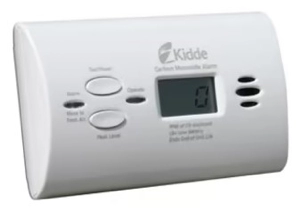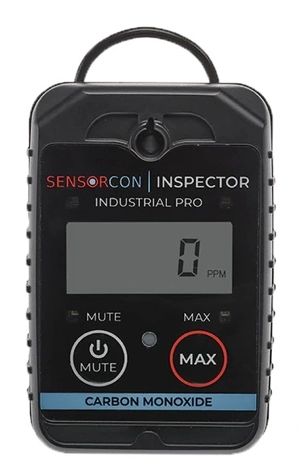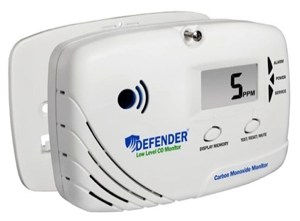If you’re looking to purchase a portable carbon monoxide detector for travel, I salute you! You are way ahead of the game my friend.
Most people don’t realize how often CO poisonings take place at hotels, resorts or even an Airbnb. Search for “carbon monoxide hotel” or “vacation carbon monoxide” in Google News and you’ll get quite a wake up call.
Do I Really Need A Portable Carbon Monoxide Detector For Travel?
Very few hotels install carbon monoxide detectors. Some firemen, physicians, activists and legislators have been pushing hotels to put them in every room. The lodging industry claims that it is not necessary and too expensive.
But using the National Fire Incident Reporting System (NFIRS) data in 2021 told a different story.
To better understand the public health risk from carbon monoxide incidents in the U.S. lodging industry, data for years 1999 through 2018 were assessed to identify CO incidents occurring at U.S. hotels and motels. The results of the study found 3405 incidents.
But that wasn’t the scary part of that study. Notice what’s stated in its conclusion…
“The harm caused to the public by these incidents is likely much greater than the NFIRS data indicates. Applying the frequencies of injury and deaths observed by the previous efforts to the NFIRS data indicates a potential for 651 to 1498 deaths and 22,336 to 38,657 injuries to have been caused by CO incidents in the U.S. lodging industry over the last 20 years.“
Now that’s scary!
Remember the old ‘Don’t Leave Home Without It’ tagline that became synonymous with American Express traveller’s cheques. It was a great marketing campaign that offered peace of mind while on vacation.
Nowadays, if you want real peace of mind when you’re traveling, pack a carbon monoxide detector…’don’t leave home without it’.
The Best Carbon Monoxide Detector For YOU (Don’t Skip This Section)
I’m going to recommend 3 portable carbon monoxide alarms that I’ve tested and used. And although we’re focusing on travel, these CO detectors can be used in a variety of ways to protect you and those around you.
Keep in mind that this is NOT a good, better and best list. All 3 carbon monoxide detectors have their pros and cons. And each detector benefits certain people. You may ask, “What do mean “certain people”? Doesn’t CO affect everyone the same? How are CO detectors built for certain people?”. Good questions.
Whenever I’m asked about which carbon monoxide detector to buy, people are usually surprised that my answer is always, “Who’s the detector for?”
I ask because every household CO detector sold today online, in department stores or in big box stores does not detect or alert when exposed to low levels of carbon monoxide. This is dangerous because low levels of carbon monoxide can cause serious health issues for some people.
It’s such a real danger that by law, manufacturers of these CO detectors are required to have a warning something similar to this wording which is found on the Kidde carbon monoxide alarm…
“This device is designed to protect individuals from acute effects of carbon monoxide exposure. It may not fully safeguard individuals with specific medical conditions. If in doubt, consult a medical practitioner. Individuals with medical problems may consider using warning devices which provide audible and visual signals for carbon monoxide concentrations under 30 PPM.”
What medical conditions or problems are they talking about? That used to be easy to see because at one time the required wording was more specific and had to include this…
“Pregnant women, infants, children, senior citizens, persons with heart or respiratory problems, and smokers may experience symptoms at lower levels of exposure than noted.”
Since that list covered the majority of households that used a CO detector, you can guess who got the wording less specific. It didn’t change the danger but it did make manufacturers less liable.
To wrap this up, keep this in mind…
When you’re shopping for a CO detector, the most important consideration is who it’s for.
If you’re a healthy, young-ish, not pregnant and only need to protect other healthy, young-ish, non-pregnant adults, you can use any CO detector you’d like.
If you’re anyone else…you need a low level carbon monoxide detector.
Two Levels Of Travel Carbon Monoxide Detector
The difference between carbon monoxide detectors boils down to when they sound an alert. Depending on whether it’s low level or a UL 2034 CO detector, it will alert based on CO levels within a certain period of time.
Any detector below will make a good portable travel detector. And they all have two important features in common. They run off batteries so there’s no worries of a power outage preventing you from being safe. And they have digital display to show how much CO is being detected.
Recommended UL 2034 Travel Carbon Monoxide Alarm (For Healthy Adults Only)

Kidde Battery Operated Carbon Monoxide Alarm with Digital Display
Specifications:
Size: 4.5 x 1.5 x 2.75 inches
Weight: 1 Pound
Reasons To Buy:
Inexpensive
Battery Powered 3-AA Batteries
Can be used at home when not traveling
Reasons To Avoid:
For Healthy Adults Only
Only alarms at dangerously high CO levels
Not designed to hold up well during travel
Cheaper CO sensor is more susceptible to false alarms
Must remove batteries to turn off while traveling
The Kidde is a simple inexpensive CO detector that’ll do the job for some. It’s easy enough to pack in a checked bag but does take up a bit of room if you’re trying to travel light with a small bag. It’s built to stay in your lodging and protect you when you’re there. The ability to see peak CO levels can be used to see if CO levels were elevated while you were out. It also has 3 AA batteries that can be easily removed so it doesn’t go off while it’s packed away.
Recommended Low Level Carbon Monoxide Alarm

Sensorcon Inspector 2 CO Industrial Pro Carbon Monoxide Gas Monitor
Specifications:
Size: 3.2 x 2.2 x 0.86 inches
Weight: 4 ounces
Reasons To Buy:
Accurate low level CO detection
Rugged design holds up during travel
Water resistant and shock proof
Temperature Range: -4 to +122 °F (-20 to +50 °C)
Adjustable alarm settings
Small and light for packing
Two-year battery life (replaceable)
Reasons To Avoid:
Not designed for home use
While all three of the recommended detector will work for travel, the Sensorcon is the most suited for it. This is the device we’ve used for years on the job to protect ourselves from dangerous situations. They are small, tough, accurate, easy to use and adjustable to fit your needs. These are also the same units used by pilots to protect themselves in smaller aircraft. So these units are in all aspects of the travel industry already!
The Sensorcon has an easy on/off button so you can save the battery when it’s not needed. It also can be attached to your person if you’re nervous about an area you might be traveling too while on vacation rather than just what’s happening in your hotel room. If you’re looking for the most complete way to protect yourself, the Sensorcon is the way to go.

Defender LL6170 Low Level Carbon Monoxide Monitor-Alarm
Specifications:
Size: 5.5 x 3.75 x 1.25 inches
Weight: 8 ounces
Reasons To Buy:
Accurate low level CO detection
Can be used at home when not traveling
Reasons To Avoid:
Non-removeable batteries
Unable to turn off
The Defender detector can be used for travel but has the advantage of being an excellent carbon monoxide detector for your home. The one downside is that it’s not as rugged as the Sensorcon so it might not hold up as well when you use it for travel. It also can’t be turned off once it’s started but since it has a high quality carbon monoxide sensor it will be less likely to give you false alarm alerts like the Kidde. Whether you use this as a travel carbon monoxide alarm or not, you won’t go wrong with one of these in your home.
Why Is Carbon Monoxide So Dangerous?
When you take a breath your lungs are taking in oxygen from the air. And those oxygen molecules, consisting of two oxygen atoms, go into your bloodstream where they bind to hemoglobin proteins which then carry the oxygen throughout your body to vital organs like your brain and heart.
When you breathe in carbon monoxide, those CO molecules, consisting of one carbon atom and one oxygen atom, take the place of the two oxygen molecules. This prevents our body from getting the oxygen that it so desperately needs. If it goes on for long enough or in high enough concentrations it will lead to a death by asphyxiation.
This is known as carbon monoxide poisoning, the silent killer.
But did you know that not all forms of carbon monoxide poisoning result from large levels of exposure in a short period of time?
Less is known about the harmful effects that lower levels of carbon monoxide exposure can have both acutely and over long periods of time. But there is research out there to suggest it’s a problem.
It has been shown that CO poisoning has both short term and long term effects. A report using long term studies indicates there are serious and permanent consequences to carbon monoxide poisoning such as neurological damage and cardiovascular complications.
One study from 1998 found that low level CO exposure led to an impairment of cognitive functions like problem solving and memory formation.
Sadly, most of the research out there on the effects of low level and long term CO exposure is old, dating back to the early 2000s or even earlier, which suggests there’s a need for more research.
Addressing the issue of low level exposure is quite complicated. Organizations like OSHA, NIOSH and the EPA have different recommended safe thresholds for CO exposure.
One says exposure to 50 parts per million (ppm) in air over eight hours is safe while others say it must stay below 9 ppm.
Who Is At Risk Of Low Level Carbon Monoxide Poisoning?
Carbon monoxide can affect anyone but we should be especially on guard if we or anyone in our household falls into these higher risk groups.
Elderly – People who are elderly are more likely to have a health problem that could cause them to be more susceptible to CO poisoning. (i.e cardiac or respiratory)
Children – This age range has a higher metabolic rate and takes more breaths than adults do, so they’re at greater risk for CO poisoning.
Pregnant Women – This group is at risk due to the fact that maternal carbon monoxide level affects fetal CO level, which impairs both mother and fetus simultaneously.
Pets – Animals are particularly vulnerable to carbon monoxide (CO) poisoning because they’re small, have a high metabolic rate, and behave differently than humans. Home carbon monoxide detectors are designed to protect people from CO poisoning, but don’t necessarily protect animals.
As we discussed earlier, normal CO alarms won’t sound at levels below 40 or 50 PPM and when they do, it requires those levels to persist for several hours or even days before they finally do sound.
What most people don’t realize is that a carbon monoxide alarm only goes off when there are deadly amounts of carbon monoxide in the house. Today’s detectors are designed to prevent deaths from high levels of CO, not injuries from chronic exposure to low levels. Sadly, they often fail at preventing deaths!
Finally, do you have a smoke detector or fire detector in your home? It’s a smoke detector, right? Why not a fire detector? Because we don’t want to be warned when our home is engulfed in flames! We want to know as soon as there is a problem so we have time to react.
UL 2034 carbon monoxide alarms and detectors are basically fire detectors. By the time they go off it could be too late.
So what can you do?
Prevention and knowledge is key. Know the sources of CO and the clues your body gives when you might be suffering from carbon monoxide poisoning.
Signs And Symptoms Of Carbon Monoxide Poisoning
Carbon monoxide poisonings can be difficult to diagnose but are classified as acute (having a sudden onset) or chronic (occurring again and again for a long time).
Acute poisoning occurs by breathing large amounts of carbon monoxide over a short period of time. Chronic poisoning occurs by breathing smaller amounts of carbon monoxide over an extended period of time.
The severity of poisoning and the subsequent symptoms depend on the total amount of carbon monoxide breathed over time, as well as the person’s physiological condition.
Signs of acute carbon monoxide poisoning can include:
- Headaches
- Unconsciousness
- Dizziness
- Breathlessness
- Nausea
- Numbness
- Vision Problems
Signs of chronic carbon monoxide poisoning can include:
- Flu-like symptoms
- Feeling better when not at suspected site of poisoning
- Impaired attention and problem-solving abilities
- Mental confusion
- Difficulty with simple arithmetic
- Memory impairments
- Disorientation
- Depression
Carbon Monoxide Poisoning Treatment
If you suspect that you or someone around you has carbon monoxide poisoning it’s important to act quickly.
Here are some steps you can take:
- Get out immediately and leave the house/business/etc.
- Call for help (e.g., 911, fire department, gas companies, etc.)
- Don’t go back into the building until you’re told it’s safe to do so by an authorized person.
- If you’re feeling unwell, call an ambulance immediately.
- Because your cognitive abilities may be impaired, do not try to drive yourself to a hospital.

